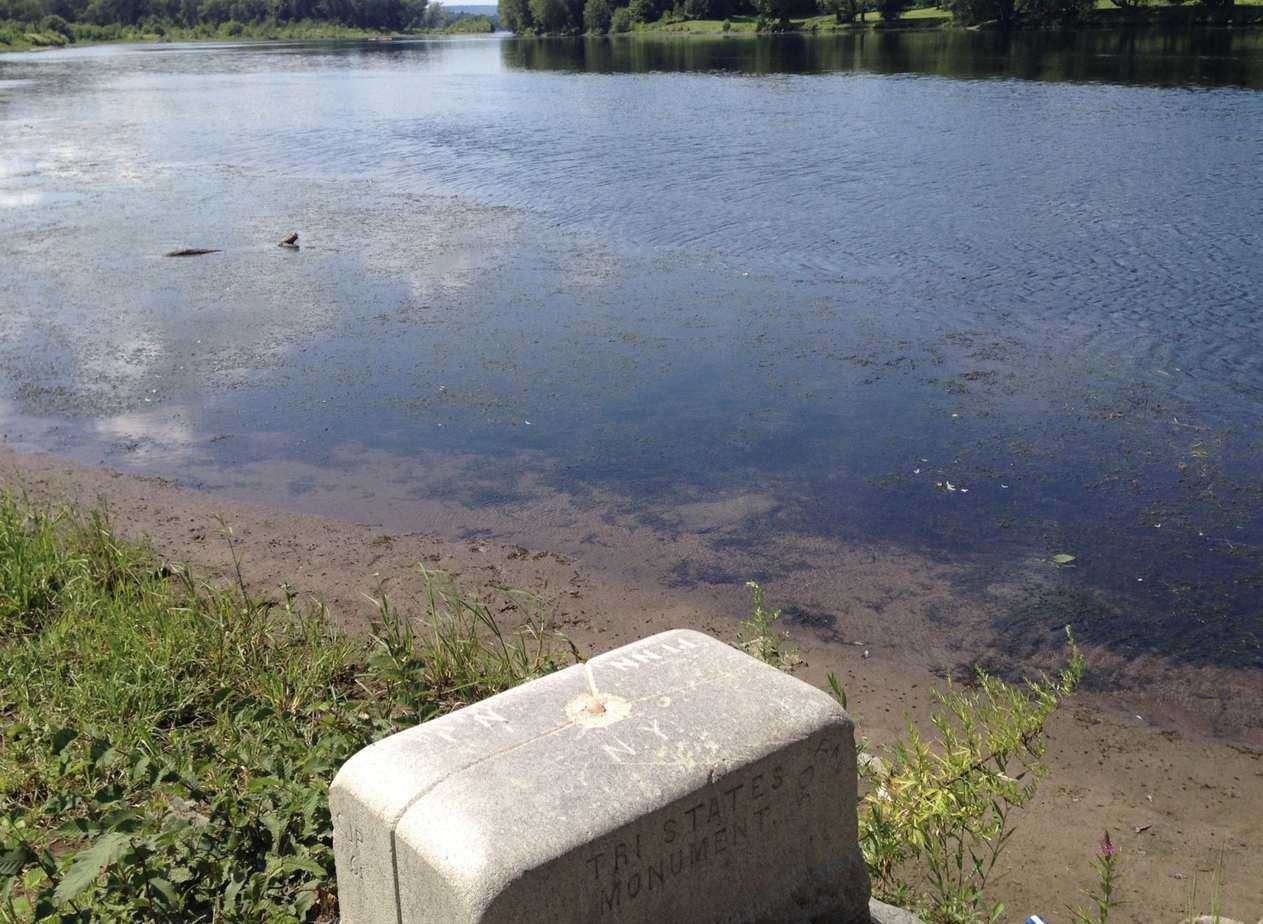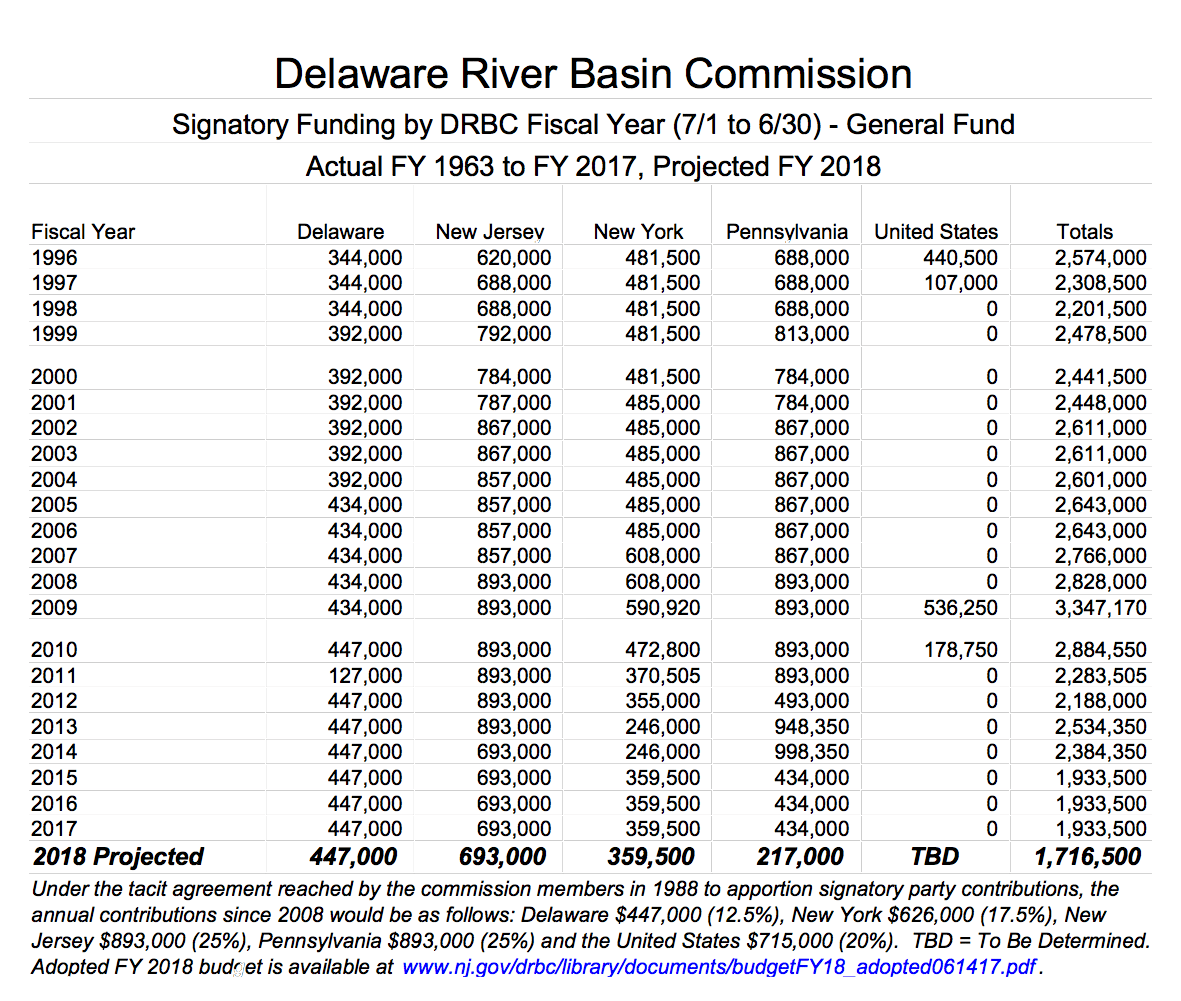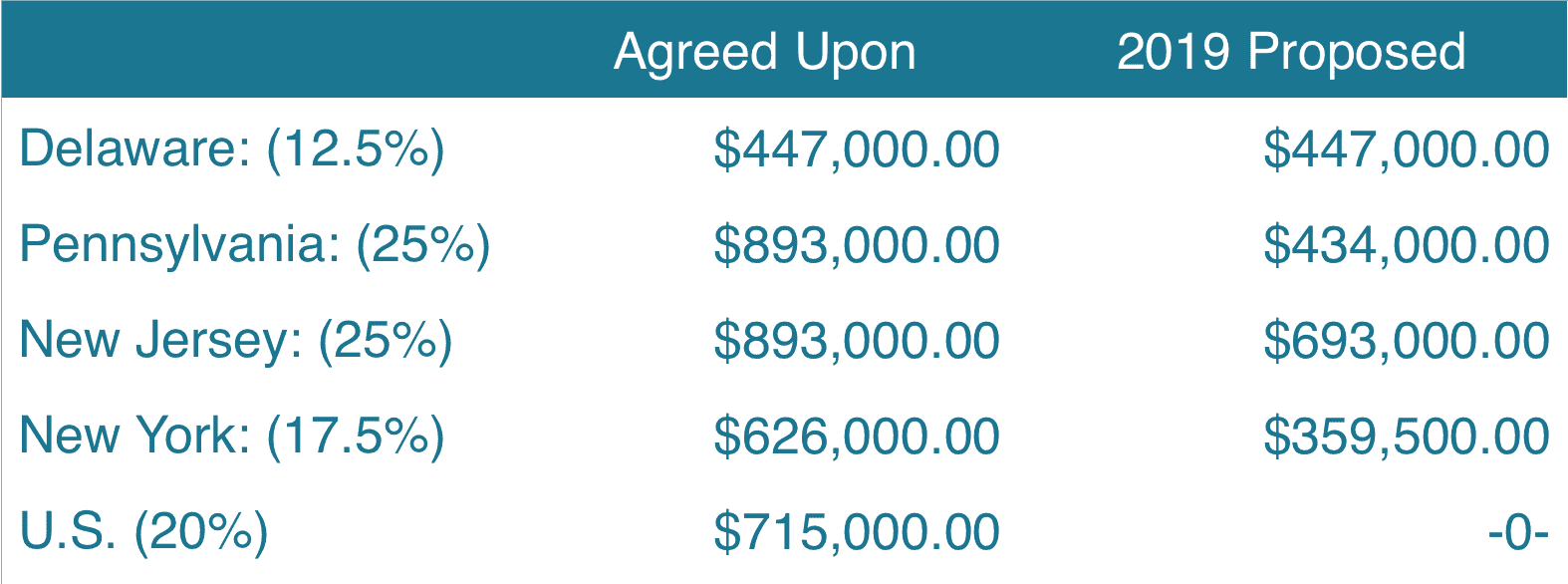#4TheDelaware? Maybe not so much
Editorial Report

Neither New York, Pennsylvania, New Jersey nor the federal government have been fully honoring their 1988 commitment to fund the Delaware River Basin Commission.
The hashtag above is the marketing tool launched this year by the National Wildlife Federation and others to encourage the river's four border states to be better caretakers of the Delaware River, which is the principal water source for 15 million people.
The only state that has consistently paid its full share -- at least most years -- is Delaware, paying $447,000, annually.
There's a lot of numbers behind this story and the best way to understand it is to visualize it. Here's a link to the DRBC's page that has a running list of the states and federal contributions since 1963.
And here's a shorter version for the recent history:

The federal government is the worst violator, having paid nothing -- yep, zero -- since 2011. In 2011/12 it paid its $715,000 (over two years) but that was a blip from the zero contributions for many years before. The federal government's representative on the commission is the U.S. Army Corps of Engineers.
Why does funding matter?
Remember, the DRBC is the agency charged with taking care of the water quality (is the water clean?) and quantity (drought/floods) of the Delaware River. As a regulator, it has fans and detractors. For example, its proposal to ban fracking in the watershed has made many people happy. They see clean water. At the same time, many people who might be interested in having fracking on their property in the watershed are decidedly unhappy. They see the loss of their right to make money off the property they own.
The "unhappiness" of various fracking interests in the state might well be behind the audit announced in February this year of both the Delaware River Basin Commission and its sister river commission, the Susquehanna River Basin Commission, to be conducted by the Pennsylvania auditor general, Democrat Eugene DePasquale.
The other dubious honor shared by both river commissions: Neither is getting its agreed-upon share of money from the federal government.
For the DRBC, that's supposed to be $715,000 annually. If you add up all the "zero" years (19) that comes to a whopping $13,585,000.
Most (about three quarters) of the DRBC's budget ($6.5 million total in the general fund) is for staff salaries and benefits. And while there are administrators and office workers, more than half of the staff are scientists working on solutions to water problems in the Delaware River.
The DRBC is a peculiar animal: Scientists pursue solutions but any solution must be approved by the commissioners themselves. Since the commissioners are the governors of the four states (and the U.S. Army Corp of Engineers, which reports to the White House) their decisions are political. The actions, or inactions, of the DRBC have to be seen in that light.
One more point to consider: If the states and the feds don't cough up funding, the DRBC will be charging higher fees for the work that they do. Some might say that's fair enough, but that puts it "in bed" as a regulator with the people it's supposed to regulate. That would make it similar to the Federal Energy Regulatory Commission, which uses the fees collected from the industries it regulates to offset its expenses.
The lack of funding makes it seem as though the states' and feds' support of the DRBC is lackluster at best. What's more, none of commissioners, or their representatives are eager to talk about why the shortfall exists.
The USACE reports to the Department of the Army and both of those have either never responded substantially to phone calls or e-mails, or respond with a suggestion to contact yet another person in the bureaucracy.
Essentially, the way federal funding works is that there has to be authorization, which has happened for this funding. Then it has to be included in the Army's budget, which hasn't happened. This has been problem for a while and one solution enacted was that if the money wasn't forthcoming, the Army has to tell the U.S. Congress why.
That hasn't happened either.
"You'd think Congress would be happy to have another thing to investigate," said Andrew D. Dehoff, executive director of the Susquehanna River Basin Commission. "We need to get the attention of the Office of Management and Budget, or Congress," he said, acknowledging: "That's a long shot."
There is one source of federal funding for the DRBC -- the Environmental Protection Agency. It's based on Section 106 of the Clean Water Act. In calendar year 2018, this money totaled $718,000 (although that money could be reduced later this year.)
But before you say "Ah-ha, that's where the fed dollars are coming from." Not so fast.
According to DRBC spokesperson Kate Schmidt, "That funding is for specific interstate Clean Water Act requirements and does not support the federal 'fair share' contributions."
OK, let's see what the states have to say.
Not much.
Let's go back to the contributions agreed upon in 1988. This was the breakdown and percentages:

Delaware has gradually increased its payments to get to $447,000 in 2012.
Pennsylvania did achieve $893,000 for four years from 2008 to 2011. It went over in 2013 and 2014, and then dropped to its low of $217,000 in 2018.
Here's what Neil Shader, press secretary for the Pennsylvania Department of Environmental Protection wrote:
The PA legislature has historically established how much Pennsylvania, through DEP’s appropriation, pays to DRBC. Despite limited fiscal resources, Governor Wolf has consistently fought to raise the allocation for the DRBC from the levels initially suggested by the legislature. In addition to the funds allocated through annual appropriations, DEP also contributes funding to the DRBC through 2 grant programs: the Southeast PA Groundwater Protection Area, funded by the Clean Water Fund; and Estuary Water Quality Monitoring, funded by Coastal Zone grants. In 2017 this amounted to an additional $183,000 for DRBC.
DRBC's Schmidt explained that the Southeast PA Groundwater Protection Area funding can't be considered as part of the state's "fair share" funding since the DRBC was asked by Pennsylvania to monitor the groundwater in southeast Pennsylvania, which is at risk in that part of the state because of the negative impact of development.
Despite what could be called badgering from Delaware Currents, the responses from both New York and New Jersey were, at best, skimpy.
Larry Hajna, press officer for New Jersey Department of Environmental Protection, cited the recent change in administration from former Gov. Chris Christie, a Republican, to Gov. Phil Murphy, a Democrat, to say that it was too soon to expect a change and that the question was "ahead of the process ' adding that "New Jersey's reduced funding is due to fiscal restraints."
After this story was initially published, a more expansive e-mail was received from Hajna:
New Jersey has a long and cooperative relationship with the DRBC and recognizes the important role the Commission serves in protecting the Delaware River and its tributaries through its efforts to improve water quality and develop science to help support the resource protection mission shared by all Compact members.
- New Jersey recognizes this commitment and continues its support of the Commission through financial and technical resource. New Jersey has contributed over $7.9 Million over the last 10 years and continues its commitment for $693,000 this year.
- The DEP is also working to identify additional funding (up to approximately $150K for the first year of three-year study) to support to a comprehensive DRBC study of dissolved oxygen in the Delaware estuary to help in achieving federal water-quality goals for the river.
- New Jersey also provides significant in-kind support to the Commission by providing staff to work on a number of advisory committees that help DRBC manage the shared resources of the Delaware River Basin. These committees focus on flooding issues, water-quality monitoring, regulated flows, toxics and water management. The participation by New Jersey and the other states on these committees provides important scientific and logistical support to help DRBC enhance protection of the river.
- New Jersey has developed the expertise to produce models of flow rates in the Delaware River based on release schedules from New York City’s reservoirs in the upper basin. DRBC has made use of this expertise to help manage flows in the river for water supply and ecological maintenance of natural resources.
New York's Department of Environmental Conservation issued a statement:
Recognizing its critically important mission, DEC is committed to continuing to fund DRBC in the amount appropriated in the New York State budget.
At its May 26 meeting the DRBC presented its proposed budget for commissioners to vote on at its next meeting on June 13.
Which Is to say it's not too late to raid the piggy banks, and see how much the states are really #4TheDelaware.
